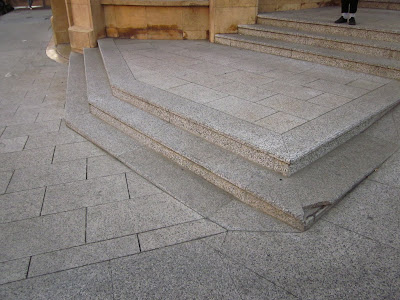
The rather sprawling geographical compression left me deposited somewhere on Charles Helou Boulevard, nearly winded from the comprehension of my geographical whereabouts.
I'm in Beirut.

Compared to Syria, Beirut was throbbing with modernity, commercialism, tension and grace. The contemporary downtown core was the result of a concerted government renovation effort throughout the 90's (post the civil war), and the area is now an oddly sterile commercial arena surrounded by condominium development projects for the urban middle class.
It carries an air similar to Robson St or SoHo, and the "beirut souks", even without comparison to the tunneled and cavernous density of those in Aleppo and Damascus, essentially parallell a mall. [More pictures (by someone else) of contemporary, cosmopolitan Beirut].
The Martyr's Statue, built in 1915, essentially marks the center of the city. It survived the civil war by accepting a rampage of bullet holes - forgoing its capacity as an echo chamber and instead becoming capable of transposing new passages of light. Here's what it looked like in 1982.

The statue is right on the Green Line - the invisible marker that separated the city into East and West during the civil war (1975-1990). The (mostly Maronite) Christians dominated the East, the (mostly Shiite) Muslims dominated the West, and the other minorities were settled amidst. There's some pretty impressive photographic documentation of what it looked like shortly after that time, here.

Within a stones throw of the Martyr's Statue, there was a Dunkin Donuts, a Virgin Megastore, the Al-Amin Mosque (which now houses the tomb of the late prime minister Rafik Hariri, assassinated in 2005), the headquarters of the Kataeb (Phanlangist) party (across the street from my hotel and plastered with the face of a late party MP, assasinated in 2006), and an Armenian catholic church (as shown below, superimposed by an urban development zoning wall).

There were tanks and machine guns and you couldn't park virtually anywhere in central Beirut due to previous issues with car bombs.
And nobody projected the slightest air of fear, and that was lovely.


It took me awhile to dissolve my own psychological fear rhetoric, working against injections from western propaganda and the iconographic associations tethered to "dangerous" - namely tanks, guns and war-scarred buildings. Things that I don't have default associations with in my societal wallpaper as a post-upper class kid residing on an island in Canada.
Beyond the reconstucted nucleus of the "Beirut Central District", the atmosphere grew a bit more authentic to its past. Pock-marked buildings, graffiti swathed in social/political/cultural strife and consciousness; and both together:




About halfway to Hamra (the university district); we passed what I later came to realize was the Holiday Inn. The hotel, now a military outpost, was a key sniper spot in West Beirut during the civil war. Initially it looked like many of the other war-scarred buildings, but the tanks and lone guard on the blasted out lower level took it beyond its historical notoriety. An inverted idea of hospitality: "hotels as incumbent military posts." A sensation augmented all the more because about 20 seconds earlier I was contemplating buying toothpaste in a pharmacy.

And so, inverted ideas of urban utility and function.

Somewhere along the line, Andrew and I came to the conclusion that Beirut (or at least, parts of it) would be a pretty sweet city to skate in. There were kids bmxing all over a downtown square in Aleppo - but Syria's got a long way to go to be skateable. As for Beirut - well, we decided to take a photo sequence. We got as far as this one.

The next attempt seemed to inadvertently include government buildings, in front of which I established a guard in my viewfinder hastily motioning us over with his machine gun. Upon crossing the road, he communicated that such pictures were not, at all, permissible. I took this to mean: "no documentation that could contribute to greater intelligience regarding the architectural nature of state buildings, which in turn, could potentially result in malicious activity towards said state buildings." Roger that, end skate collection.
Instead, we rode the ferris wheel.

One night we rode the ferris wheel, one night I danced to This Charming Man with a smashing arab lad in a jean jacket a few blocks down an alley from a restaurant called Corleone,
 one night I won an iPod in the u-district - though we never got into the University. Apparently I didn't play my AUB student life card very well by inquiring with the guard at the entrance.
one night I won an iPod in the u-district - though we never got into the University. Apparently I didn't play my AUB student life card very well by inquiring with the guard at the entrance.
Quite a throbbing little world. Sweeping away debris and manifesting anew. In the sixties Beirut was referred to as the "Paris of the East", which seems both ethnocentric and short-sighted, but then, we are essentially talking about global perceptions imprinted by colonialism.
"Triangulated City", perhaps.
For everything that forms a base, there's something standing on the other side, connected in opposition.
No comments:
Post a Comment